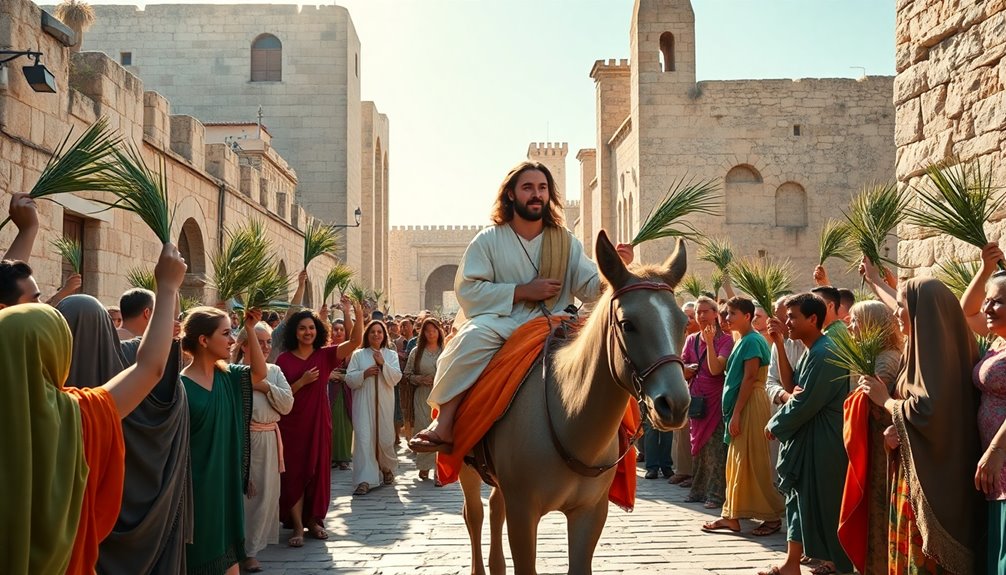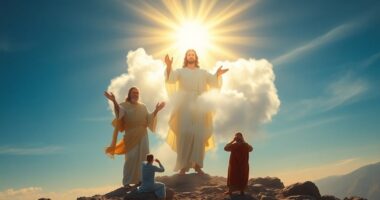When Jesus entered Jerusalem on a donkey, it was a powerful moment that highlighted His humility. This act fulfilled the prophecy from Zechariah and challenged traditional views of kingship. The crowds welcomed Him with excitement, laying down cloaks and palm branches, shouting "Hosanna!" This entry revealed Jesus' mission of peace and love, offering spiritual salvation. You'll find more insights about His incredible journey and its significance as you explore further.
On the first Palm Sunday, Jesus made a profound statement as He entered Jerusalem on a donkey, fulfilling the prophecy from Zechariah 9:9. This moment marked a significant shift in the way people viewed Him, as His entry into the city wasn't just a simple ride; it was a Triumphal entry that resonated with deep spiritual meaning.
As you imagine the scene, picture Jesus approaching Jerusalem from the Mount of Olives, where He instructed His disciples to fetch a donkey and its colt. This choice emphasized His humble yet royal kingship, contrasting sharply with the expectations many held for a conquering hero.
As Jesus rode into the city, crowds gathered, laying their cloaks and palm branches on the road, creating a pathway fit for a king. They shouted "Hosanna," a cry of praise that recognized Him as the Son of David, showcasing their messianic hopes. You can feel the excitement in the air, as the people welcomed Him with open hearts, believing He was the one who'd deliver them. The atmosphere was electric, filled with anticipation and joy, yet tinged with the complexity of their expectations.
The choice of a donkey for this entry is especially telling. In biblical times, a donkey symbolized peace, a stark contrast to the warhorses typically used in triumphal entries. This decision reflects Jesus' mission of spiritual salvation rather than earthly conquest.
As you witness this event, you realize that His entry into Jerusalem wasn't about seizing power; it was about offering a different kind of kingdom—one rooted in love, grace, and redemption.
This moment stirred the city of Jerusalem, prompting questions about Jesus' identity. People whispered among themselves, trying to reconcile their expectations with the reality of who He was. This entry foreshadowed the events of Holy Week, leading to His crucifixion and resurrection. It serves as a pivotal moment in the story of Jesus, where hope and misunderstanding intertwined.
As you reflect on this significant event, consider how it challenges your understanding of kingship and authority. Jesus' entry into Jerusalem on a donkey invites you to embrace a different kind of leader—one who reigns not through power and might, but through humility and love.
Frequently Asked Questions
What Is the Story of Jesus Entering Jerusalem on a Donkey?
You've probably heard about Jesus' entry into Jerusalem on a donkey.
It's a powerful moment where He fulfills prophecy and shows His humble kingship. As you read, you can picture the crowd laying down cloaks and palm branches, shouting "Hosanna!" They recognize Him as the Messiah, filled with hope for liberation.
This joyful procession stirs the city, setting the stage for the events of Holy Week that follow, blending celebration with impending conflict.
Where in the Bible Does It Say Jesus Came Riding on a Donkey?
Imagine you're at a parade, and instead of a flashy car, the guest of honor arrives on a humble bicycle.
That's how Jesus came riding into Jerusalem. You can find this account in Matthew 21:5, where it says, "Say to daughter Zion, 'See, your king comes to you, gentle and riding on a donkey.'"
This moment highlights His humility and fulfillment of prophecy, setting the stage for a new kind of kingship.
Where in the Bible Does It Talk About Jesus Triumphal Entry Into Jerusalem?
You can find the account of Jesus' triumphal entry into Jerusalem in all four Gospels.
In Matthew 21:1-11, Mark 11:1-10, Luke 19:28-40, and John 12:12-19, each Gospel highlights the moment when crowds welcomed Him with shouts of praise.
They spread cloaks and palm branches, recognizing Him as the Messiah.
This event fulfilled prophecy and set the stage for the significant events leading up to His crucifixion.
What Is the Story of Jesus Donkey?
You might think a donkey isn't fit for a king, but that's precisely the point in the story of Jesus and His donkey.
He instructed His disciples to fetch a donkey and its colt, symbolizing humility and peace. As He rode into Jerusalem, crowds celebrated, recognizing Him as the Messiah.
This choice emphasizes His mission to bring spiritual salvation, contrasting with the traditional display of power associated with horses in royal entries.
Conclusion
As you reflect on Jesus' humble arrival in Jerusalem, you can't help but sense the profound significance behind this gentle procession. Riding a donkey, He embraced the role of peace and humility, subtly foreshadowing the trials ahead. It's a poignant reminder that true strength often wears the guise of simplicity. In this moment, the world witnessed not just a king, but a savior, quietly inviting hearts to embrace a path of love and redemption amidst the turmoil.










